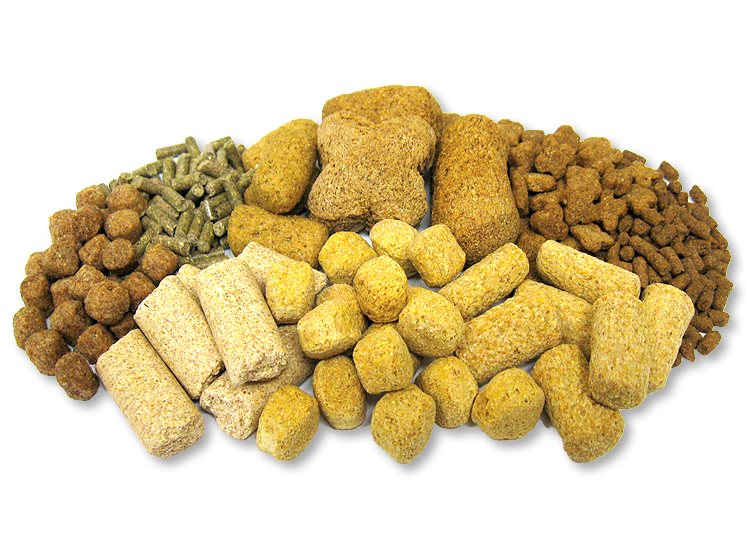Purified high fat diets used to induce obesity and obesity-related complications such as diabetes and metabolic syndrome typically have 40-60% of energy derived from fat. The diet tables below summarize relevant diet features for several Teklad custom research diets commonly used in rodent models.
Teklad also creates high-fat diets for other species, including pigs, primates, and canines. Contact us to discuss the use of these diets or one that better meets your needs.
Commonly-used diet-induced obesity (DIO) Teklad rodent diets with 55-60% of calories from fat
| Diet features | TD.06414 stocked | TD.93075 dough | TD.07011 pellet |
|---|---|---|---|
| Kcal/g | 5.1 | 4.8 | 4.8 |
| Fat, % Kcal | 60 | 55 | 55 |
| Fat Sources,% by weight | 31% lard 3% soybean oil |
27.4% vegetable shortening 1.6% corn oil |
27.4% vegetable shortening 1.6% corn oil |
| Calculated fatty acid profile, % total fat | 36% saturated 41% monounsaturated 23% polyunsaturated |
24% saturated 61% monounsaturated (cis + trans) 15% polyunsaturated (cis + trans) |
24% saturated 61% monounsaturated (cis + trans) 15% polyunsaturated (cis + trans) |
| Sucrose, % by weight | 12.1 | 9.6 | 9.6 |
| Notes | 60F10S poster data Compare to D12492 |
Trans fat | Trans fat |
| Example modifications | TD.08500 coconut oil TD.09766 milk fat |
||
| Ingredient matched, low fat control diets* | TD.06416 (35% sucrose) TD.08806 (11% sucrose) |
TD.120651 (7% sucrose) | TD.120651 (7% sucrose) |
| References | Mouse Rat |
Mouse Rat |
Mouse Rat |
*Control diets can be designed in several ways, depending on what features the researcher wants to modify relative to the high-fat diet. These are just a few examples.
Commonly-used diet-induced obesity (DIO) Teklad rodent diets with 40-45% of calories from fat
| Diet features | TD.06415 | TD.08811 | TD.88137 stocked | TD.95217 |
|---|---|---|---|---|
| Kcal/g | 4.6 | 4.7 | 4.5 | 4.3 |
| Fat, % Kcal | 45 | 45 | 42 | 40 |
| Fat sources, % by weight | 19.5% lard 3% soybean oil |
21% milk fat 2% soybean oil |
21% milk fat | 10.6% vegetable shortening 4% milk fat 4% soybean oil |
| Fatty acid profile,% total fat | 35% saturated 40% monounsaturated 25% polyunsaturated |
61% saturated 30% monounsaturated 9% polyunsaturated |
66% saturated 30% monounsaturated 4% polyunsaturated |
31% saturated 47% monounsaturated (cis + trans) 22% polyunsaturated (cis + trans) |
| Sucrose,% by weight | 22.8 | 36.8 | 34.5 | 15.8 |
| Notes | Compare to D12451 | 45F30S poster data | "Western Diet"Cholesterol added | Trans fat |
| Example modifications | TD.110716 milk fat TD.10670 no dye |
TD.130784 lard TD.120438 no dye |
TD.07201 lard TD.00573 h-coconut oil, no cholesterol TD.09682 blue dye |
TD.07734 green dye |
| Ingredient matched, low fat control diets* | TD.06416 (35% sucrose) TD.110675 (18% sucrose) |
TD.120455 (6% sucrose, resistant starch) TD.120724 (14% sucrose) |
TD.05230 (34% sucrose) TD.08485 (12% sucrose) |
TD.06101 (6% sucrose) |
| References | Mouse Rat |
Mouse Rat |
Mouse Rat |
Mouse Rat |
Diets for diet-induced obesity (DIO)
Diets with 55-60% of calories from fat like TD.06414 and TD.93075 are commonly used for inducing obesity in rodents. While considered extreme compared to typical human fat consumption, these diets are effective in initiating rapid weight gain in most rodents. With higher fat content there is less room for carbohydrate, thus the carbohydrate (particularly sucrose) amount is relatively low compared to other obesity inducing diets. If you are interested in high fat and high carbohydrate, look at diets with 40-45% of calories from fat (often referred to as western diets).
As the fat level increases, pellet quality (durability) is often compromised. Some higher fat formulas are available only in non-pelleted form or require specific carbohydrate, maltodextrin, for pelleting. Depending on the fat and carbohydrate sources used, the non-pelleted form could be dense and crumbly, dough-like, or paste-like. Though a little more challenging to work with, non-pelleted diet is still used by many researchers for diet-induced obesity models as these researchers suspect the softer form may enhance obesity development.
Diets with 40-45% of calories from fat, like TD.95217 , TD.88137 , TD.06415 , and TD.08811 , represent another popular diet pattern for diet-induced obesity work. These diets have double or triple the amount of sucrose found in higher fat diets. High levels of simple carbohydrate like sucrose and fructose may help to promote hypertriglyceridemia, insulin resistance, and fatty liver. Diets with a pattern of high sucrose and high saturated or trans fat are often referred to as “Western Diets” in obesity and cardiovascular fields. Some “Western Diets” have further modifications to the fatty acid profile or even specific vitamin and minerals adjustments to be even more closely matched to a Western Diet pattern. For specific fatty acid modifications, see examples on our fat/lipid adjusted diets page.
Diets for diet-induced diabetes
Many of the same diets used for inducing obesity in rodents can be used to enhance diabetes related phenotypes like insulin resistance and glucose intolerance. However, fasting hyperglycemia characteristic of diabetes (glucose > 200 mg/dL) is uncommon with a diet only approach. Pre-feeding a high fat diet to induce a certain level of obesity and insulin resistance and then giving low-dose streptozotocin (STZ) may be an effective approach if overt hyperglycemia is desired.
Ingredient matched, low-fat DIO control diets
There are many options with different levels and types of fat in addition to different types of carbohydrate ranging from sucrose (highly refined, simple digestion) to corn starch (refined, but more complex) to resistant starch (refined, but not fully digestible). A very basic purified control diet would be AIN-93M (TD.94048 ) or AIN-93G (TD.94045 ). AIN-93 diets have a moderate amount of sucrose at ~10%, and fat is from soybean oil with a healthy fatty acid profile. Additional examples of controls for specific DIO diets can be found in the above tables. Learn more about AIN diet formulas.
Many researchers choose to compare their high fat fed animals to animals fed a natural ingredient, grain-based diet (also referred to as standard diets or chow). These diets differ in the source and level of nutrients as well as in the presence of non-nutritive factors (such as phytates or phytoestrogens). Depending on what your main comparisons are, it may be suitable to have a grain-based diet as your control/reference group. However, making such comparisons limits inferences to dietary patterns versus a specific dietary component.

Ask a nutritionist
Live chat Live chat
Teklad diet selector
Selector app Selector app
SCIENTIFIC INSIGHTS
Keep up-to-date with the latest industry thinking and scientific insights
Explore today Explore today
More than 90 years of working together, to build a healthier and safer world
Explore our history Explore our history



